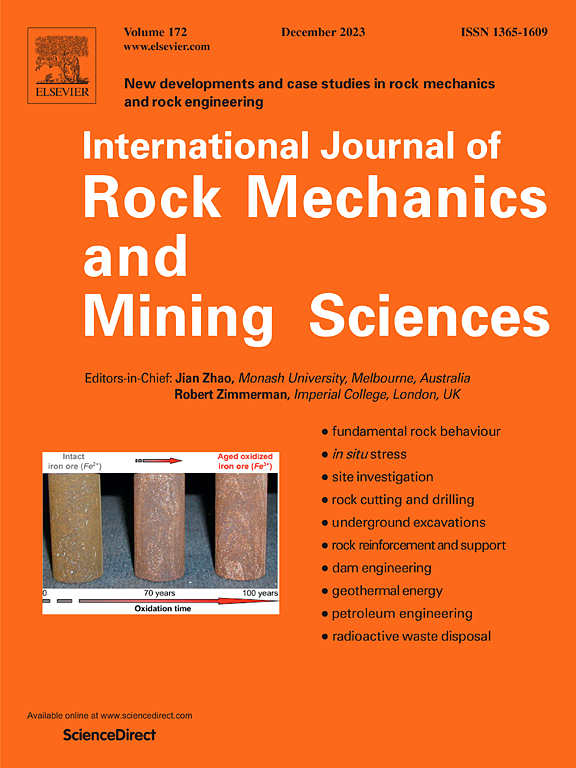Comprehensive evaluation of three-dimensional Hoek–Brown strength criteria: Properties, applicability, and parameter reliability
IF 7.5
1区 工程技术
Q1 ENGINEERING, GEOLOGICAL
International Journal of Rock Mechanics and Mining Sciences
Pub Date : 2025-07-14
DOI:10.1016/j.ijrmms.2025.106213
引用次数: 0
Abstract
The Hoek–Brown (HB) criterion has evolved into a mature and widely adopted parameter system in rock mechanics. Although existing three-dimensional HB criteria consider the intermediate principal stress effect, issues concerning the reliability of their parameters and the inheritance of the HB parameter system remain insufficiently addressed. In this study, the failure strength distribution of sandstone on the π-plane is obtained through true triaxial failure test under the given stress conditions. The non-convexity of the rock strength on the π-plane is experimentally demonstrated for the first time, and its dual nonlinear tension-compression transition law on both the π-plane and the meridian plane is revealed. Based on 50 sets of true triaxial test data, a comparative analysis of 12 HB series criteria is conducted. The results indicate that the curvilinear hexagonal strength criterion is more consistent with the failure strength envelope morphology of sandstone and has a better comprehensive strength prediction accuracy of various rock types. Among criteria without introducing additional parameters, the generalized Zhang–Zhu criterion demonstrates the best comprehensive performance, maintaining the inheritance of the accumulated experience of the HB parameter system and facilitating practical engineering applications. While criteria incorporating additional parameters achieve higher prediction accuracy and parameter stability, their practical application is limited by ambiguous physical interpretations, immature parameter determination methods, and potential disruption of the original HB parameters, lacking guiding significance for rock mass engineering.
三维Hoek-Brown强度准则的综合评价:性能、适用性和参数可靠性
Hoek-Brown (HB)准则已发展成为岩石力学中一个成熟且被广泛采用的参数体系。虽然现有的三维HB准则考虑了中间主应力效应,但其参数的可靠性和HB参数系统的继承性问题仍然没有得到充分的解决。本研究通过给定应力条件下的真三轴破坏试验,得到了砂岩在π面上的破坏强度分布。首次通过实验证明了岩石强度在π面上的非凸性,揭示了其在π面和子午面的双重非线性拉压过渡规律。基于50组真三轴试验数据,对12个HB系列判据进行了对比分析。结果表明,曲线六角形强度准则与砂岩的破坏强度包络形态更为吻合,对各种岩石类型具有较好的综合强度预测精度。在不引入额外参数的准则中,广义Zhang-Zhu准则综合性能最好,保持了HB参数体系积累经验的继承性,便于实际工程应用。虽然加入附加参数的准则具有较高的预测精度和参数稳定性,但其实际应用受到物理解释不明确、参数确定方法不成熟以及原有HB参数可能被破坏等因素的限制,对岩体工程缺乏指导意义。
本文章由计算机程序翻译,如有差异,请以英文原文为准。
求助全文
约1分钟内获得全文
求助全文
来源期刊
CiteScore
14.00
自引率
5.60%
发文量
196
审稿时长
18 weeks
期刊介绍:
The International Journal of Rock Mechanics and Mining Sciences focuses on original research, new developments, site measurements, and case studies within the fields of rock mechanics and rock engineering. Serving as an international platform, it showcases high-quality papers addressing rock mechanics and the application of its principles and techniques in mining and civil engineering projects situated on or within rock masses. These projects encompass a wide range, including slopes, open-pit mines, quarries, shafts, tunnels, caverns, underground mines, metro systems, dams, hydro-electric stations, geothermal energy, petroleum engineering, and radioactive waste disposal. The journal welcomes submissions on various topics, with particular interest in theoretical advancements, analytical and numerical methods, rock testing, site investigation, and case studies.

 求助内容:
求助内容: 应助结果提醒方式:
应助结果提醒方式:


